Churches
| The Church of St Lawrence The general appearance of the church can best be described as Georgian Gothic, and in its present form comprises nave and four bays with aisles, sanctuary with shallow apsidal east end of semi-circular outline, west tower, south porch, and also a small porch in the angle between the apse and the south aisle. The interior ceiling is oak panelled, and the beautiful stained glass windows were added at the end of the 19th century when the original windows were each replaced by subscription to commemorate specific events. The Rev. J. B. Anstice, who was Vicar from 1866 until 1894, is commemorated in 3 of the windows. The west tower, which is of three stages and has an embattled parapet with angle pinnacles, contains a peal of eight bells and a Sanctus bell. The original church had only three bells and a Sanctus bell. |
| The Methodist Church John and Charles Wesley were Church of England priests in the 18th century. They felt called to bring the word of God to non-churchgoers and to address some of the pressing social issues of the day, matters not high on the agenda of the Established Church at that time. In due course this became a separate denomination known as the Methodist Church. John Wesley died in 1791 but the first Methodist Church that can be traced in Hungerford was built in Church Street in 1807. It is intriguing that in the deeds it is recorded that the Chapel was built on a previous Wesleyan site. There is no record of this earlier Chapel though it might well have been a private house where the owner allowed meetings to take place. In 1869 the Wesleyan Methodists moved from Church Street to Bath Road where a fine Gothic Church had been built. As was customary in Methodist churches, there was a day school attached to both Church Street and Bath Road. With the increase in traffic in the 20th century, this proved to be a poor site both as a Church and School as people found it difficult to cross the busy road and in 1971 it was finally closed. They formed a group in a/house at the town end of Salisbury Road. By the 1860's this was too small and a new Church was built in 1868 in Bridge Street, hardly a stone's throw from the Wesleyan Methodists in Bath Road opened a year later. Both churches in the 19th century were very well attended. In 1932 the various splits in Methodism were brought together by the Deed of Union and one Methodist Church was formed. This was more easily done on paper than in reality and in Hungerford both Wesleyan and Primitives continued to meet separately until Bath Road was closed in 1971. The Wesleyans were invited to join with the Primitives at Bridge Street but many found themselves unable to do so. In 1993 Bridge Street was refurbished, chairs installed instead of pews, a garden established by the river, and other improvements made. This year a modem kitchen has been installed in the Hall to continue the Methodist tradition of hospitality. Much work continues to be done there to make the Church relevant within the town and to help where possible in a wider context. Bridge Street has a reputation for being a warm and welcoming Church in which to worship. More information about the Church may be found by going to; |
|
Church on the Rock Website: www.churchontherockhungerford.org Email: info@churchontherockhungerford.org Telephone: 01672 841110 / 07977 579666 |
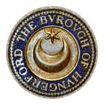
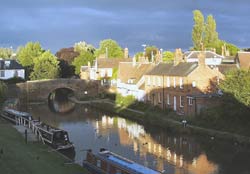
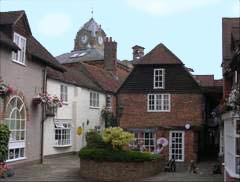
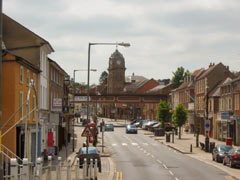
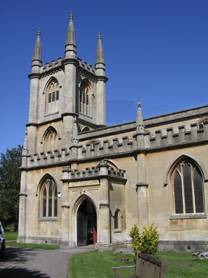 The Church of St Lawrence in Hungerford was built in 1816 to replace the earlier church, which had collapsed, and had stood, it is believed, on the same site for nearly 700 years. It was constructed in Bath stone, which was brought to the site by the newly opened Kennet and Avon Canal , and was designed by Mr James Pinch of Bath , who had also designed a nearly identical church at Bathwick in Bath . However in the latter part of the 19th Century, it was felt that the interior and the profile of the exterior could be improved. The interior of the church was re-ordered at a cost of nearly £3000, when decorated style arcades of Bath stone replaced the original cast iron pillars, and on the exterior the majority of the battlements were replaced with plain coping. At the same time a new organ was installed at a cost of just over £500.
The Church of St Lawrence in Hungerford was built in 1816 to replace the earlier church, which had collapsed, and had stood, it is believed, on the same site for nearly 700 years. It was constructed in Bath stone, which was brought to the site by the newly opened Kennet and Avon Canal , and was designed by Mr James Pinch of Bath , who had also designed a nearly identical church at Bathwick in Bath . However in the latter part of the 19th Century, it was felt that the interior and the profile of the exterior could be improved. The interior of the church was re-ordered at a cost of nearly £3000, when decorated style arcades of Bath stone replaced the original cast iron pillars, and on the exterior the majority of the battlements were replaced with plain coping. At the same time a new organ was installed at a cost of just over £500.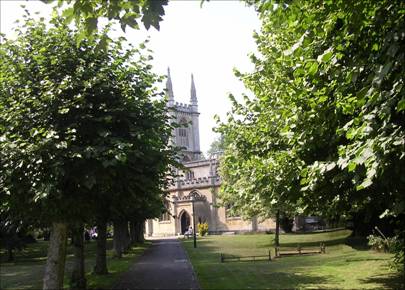 On the South side of the previous church had stood the Chantry chapel founded in 1325 by Sir Robert Hungerford, in memory of his wife Geva. This was demolished at the time of the Reformation, but Sir Robert's much mutilated effigy still lies in the church today together with the inscribed stone which contains the indulgence of 550 days for all who pray for the soul of Sir Robert and his wife. The Patrons of the living are the Dean and Chapter of Windsor , but the rectorial tithes are by exchange transferred to the Dean and Chapter of Winchester. The living passed to Windsor at the beginning of the 15th Century when the Hungerford Church and lands became the property of the Crown.
On the South side of the previous church had stood the Chantry chapel founded in 1325 by Sir Robert Hungerford, in memory of his wife Geva. This was demolished at the time of the Reformation, but Sir Robert's much mutilated effigy still lies in the church today together with the inscribed stone which contains the indulgence of 550 days for all who pray for the soul of Sir Robert and his wife. The Patrons of the living are the Dean and Chapter of Windsor , but the rectorial tithes are by exchange transferred to the Dean and Chapter of Winchester. The living passed to Windsor at the beginning of the 15th Century when the Hungerford Church and lands became the property of the Crown.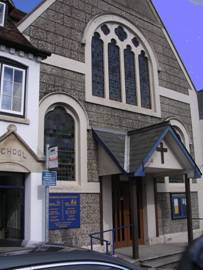 The enthusiasm of the 18th Century reformers known as Wesleyan Methodists had waned after the death of John Wesley and by 1811 a new Church known as Primitive Methodists was formed. It was not until 1833 that Hungerford experienced the enthusiasm of the Primitives when evangelists Thomas Russell and John Hyde came into the town.
The enthusiasm of the 18th Century reformers known as Wesleyan Methodists had waned after the death of John Wesley and by 1811 a new Church known as Primitive Methodists was formed. It was not until 1833 that Hungerford experienced the enthusiasm of the Primitives when evangelists Thomas Russell and John Hyde came into the town.